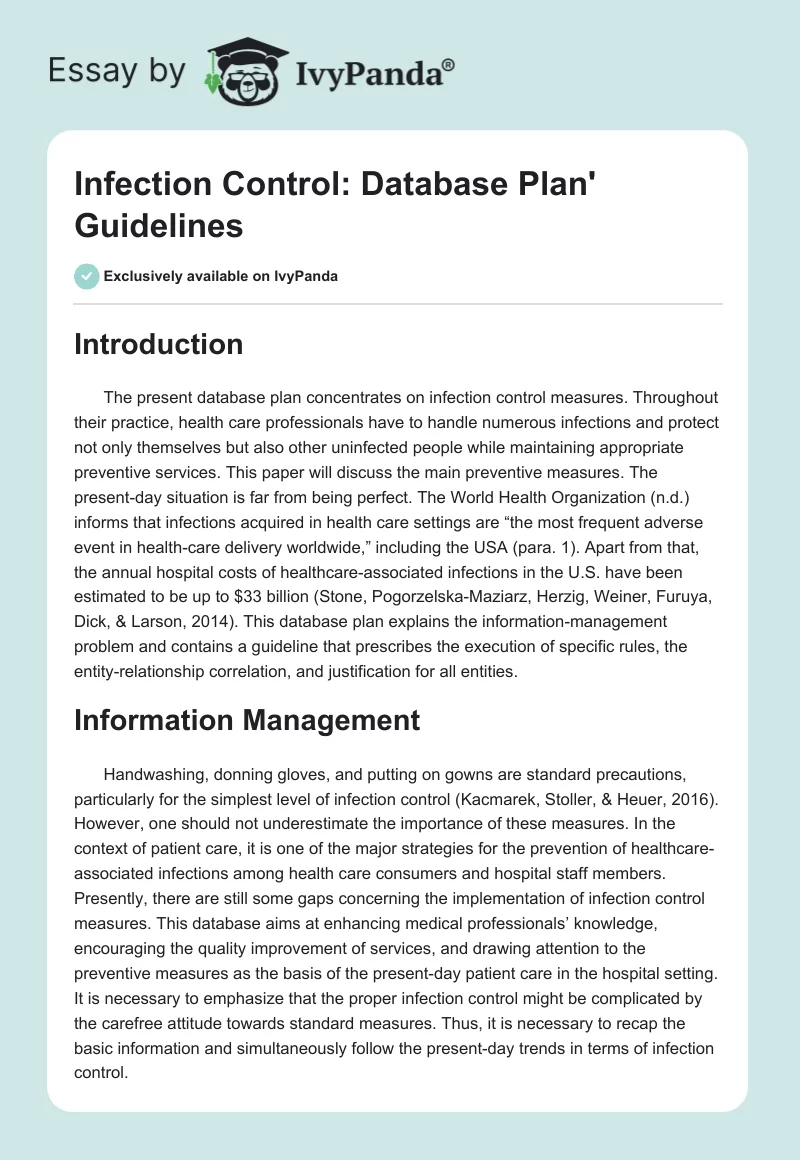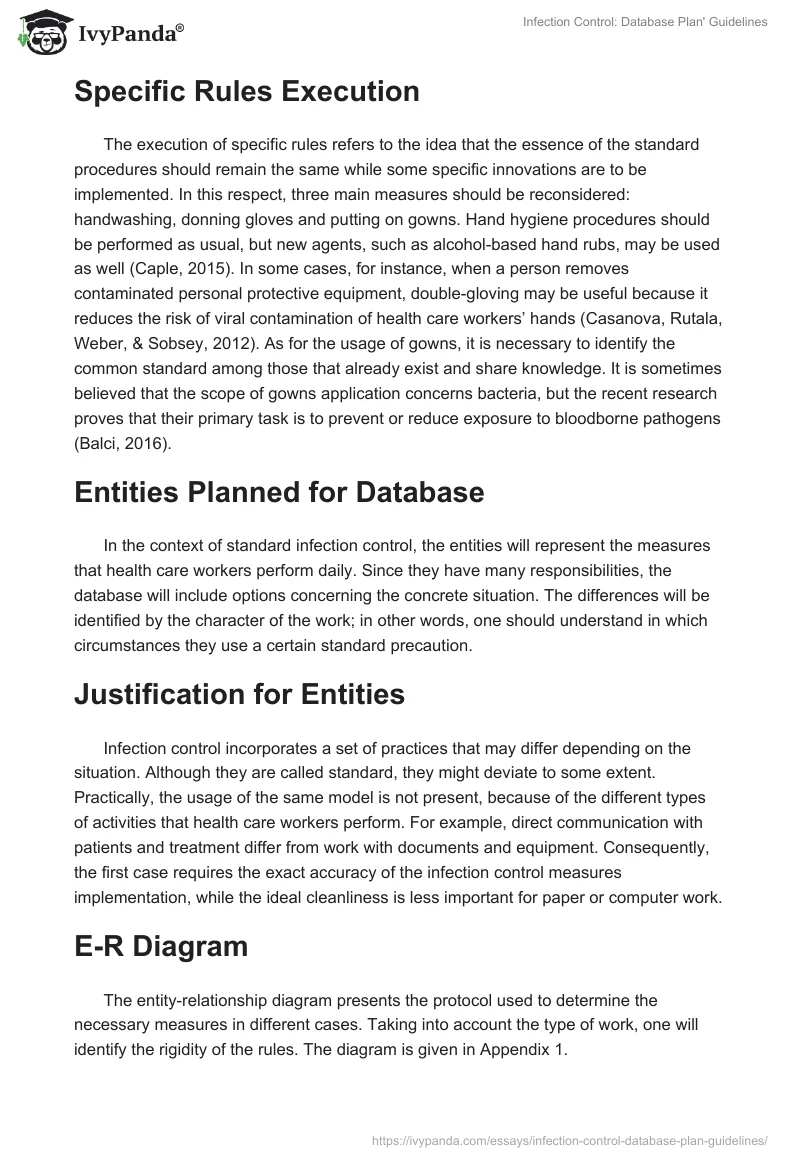Introduction
The present database plan concentrates on infection control measures. Throughout their practice, health care professionals have to handle numerous infections and protect not only themselves but also other uninfected people while maintaining appropriate preventive services. This paper will discuss the main preventive measures. The present-day situation is far from being perfect. The World Health Organization (n.d.) informs that infections acquired in health care settings are “the most frequent adverse event in health-care delivery worldwide,” including the USA (para. 1). Apart from that, the annual hospital costs of healthcare-associated infections in the U.S. have been estimated to be up to $33 billion (Stone, Pogorzelska-Maziarz, Herzig, Weiner, Furuya, Dick, & Larson, 2014). This database plan explains the information-management problem and contains a guideline that prescribes the execution of specific rules, the entity-relationship correlation, and justification for all entities.
Information Management
Handwashing, donning gloves, and putting on gowns are standard precautions, particularly for the simplest level of infection control (Kacmarek, Stoller, & Heuer, 2016). However, one should not underestimate the importance of these measures. In the context of patient care, it is one of the major strategies for the prevention of healthcare-associated infections among health care consumers and hospital staff members. Presently, there are still some gaps concerning the implementation of infection control measures. This database aims at enhancing medical professionals’ knowledge, encouraging the quality improvement of services, and drawing attention to the preventive measures as the basis of the present-day patient care in the hospital setting. It is necessary to emphasize that the proper infection control might be complicated by the carefree attitude towards standard measures. Thus, it is necessary to recap the basic information and simultaneously follow the present-day trends in terms of infection control.
Specific Rules Execution
The execution of specific rules refers to the idea that the essence of the standard procedures should remain the same while some specific innovations are to be implemented. In this respect, three main measures should be reconsidered: handwashing, donning gloves and putting on gowns. Hand hygiene procedures should be performed as usual, but new agents, such as alcohol-based hand rubs, may be used as well (Caple, 2015). In some cases, for instance, when a person removes contaminated personal protective equipment, double-gloving may be useful because it reduces the risk of viral contamination of health care workers’ hands (Casanova, Rutala, Weber, & Sobsey, 2012). As for the usage of gowns, it is necessary to identify the common standard among those that already exist and share knowledge. It is sometimes believed that the scope of gowns application concerns bacteria, but the recent research proves that their primary task is to prevent or reduce exposure to bloodborne pathogens (Balci, 2016).
Entities Planned for Database
In the context of standard infection control, the entities will represent the measures that health care workers perform daily. Since they have many responsibilities, the database will include options concerning the concrete situation. The differences will be identified by the character of the work; in other words, one should understand in which circumstances they use a certain standard precaution.
Justification for Entities
Infection control incorporates a set of practices that may differ depending on the situation. Although they are called standard, they might deviate to some extent. Practically, the usage of the same model is not present, because of the different types of activities that health care workers perform. For example, direct communication with patients and treatment differ from work with documents and equipment. Consequently, the first case requires the exact accuracy of the infection control measures implementation, while the ideal cleanliness is less important for paper or computer work.
E-R Diagram
The entity-relationship diagram presents the protocol used to determine the necessary measures in different cases. Taking into account the type of work, one will identify the rigidity of the rules.

Identifier for Entities
In this database, nurses are the primary identifiers for the type of work. Further, the work object is the identifier for particular precautions.
Relationships Among Entities
Infection prevention and control programs assume innovations, including the changes in precaution issues (Stone et al., 2014). The entities complement each other. Each of them is equally significant because the absence of one preventive measure will result in infection even if other precautions are taken.
Questions for the Database
- What measures should be taken in terms of direct patient care?
- Which measures can be adopted to a certain situation, and which are invariable?
- Can additional versions of the same preventive measure be added to the database?
Conclusion
To sum up, precautionary measures remain the most significant instrument in the context of infection control. This paper emphasized the key preventive services and shed light on the possibility of changes implementation. Apart from that, the idea about the concrete situation and corresponding measures was conveyed. The execution of specific rules was explained and represented using the entity-relationship diagram. One can use the database to learn about and teach the importance of infection control measures and decision-making about the standard precautions and their variables.
References
Balci, F. S. K. (2016). Isolation gowns in health care settings: Laboratory studies, regulations and standards, and potential barriers of gown selection and use. American Journal of Infection Control, 44(1), 104-111.
Caple, C. (2015). Hand hygiene: Hand and arm drying following surgical scrub. Web.
Casanova, L. M., Rutala, W. A., Weber, D. J., & Sobsey, M. D. (2012). Effect of single-versus double-gloving on virus transfer to health care workers’ skin and clothing during removal of personal protective equipment. American Journal of Infection Control, 40(4), 369-374.
Kacmarek, R. M., Stoller, J. K., & Heuer, A. (2016). Egan’s fundamentals of respiratory care. St. Louis, MO: Elsevier Health Sciences.
Stone, P. W., Pogorzelska-Maziarz, M., Herzig, C. T., Weiner, L. M., Furuya, E. Y., Dick, A., & Larson, E. (2014). State of infection prevention in US hospitals enrolled in the National Health and Safety Network. American Journal of Infection Control, 42(2), 94-99.
World Health Organization. (n.d.). Health care-associated infections. Web.


